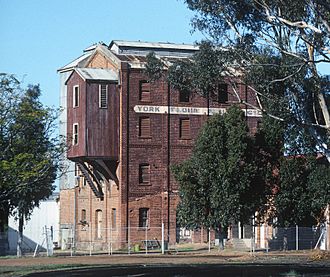York Flour Mill facts for kids
Quick facts for kids York Flour Mill |
|
|---|---|

The York Flour Mill
|
|
| Former names | Empire Roller Flour Mill, Jah Roc Furniture, The Old Mill, York |
| General information | |
| Address | 10 Henrietta St |
| Town or city | York, Western Australia |
| Opened | 1892 |
| Official name | York Flour Mill |
| Type | State Registered Place |
| Designated | 31 December 1993 |
| Reference no. | 2872 |
The York Flour Mill is an important old building in York, Western Australia. It was built in 1892 to grind wheat into flour. This flour was used in York and nearby areas. Some of it was even sent to other countries. The mill is the only one left in York. York became rich because it grew a lot of wheat and other grains.
Contents
Building the Mill
The York Flour Mill was built in 1892. It was made for a company called Empire Roller Flour Milling Co. The mill officially opened on May 24, 1892. Many people came to watch the opening. Everyone involved was very hopeful it would be a success. At that time, it was the biggest flour mill in all of Western Australia.
In 1893, a local newspaper called the Eastern Districts Chronicle wrote about the mill. They said it was the best mill in the area. They noted that the building had the newest and best milling machines. There were huge piles of wheat next to the mill. This showed how much grain the area could produce.
In 1896, a man named William Dinsdale Jr. became the manager. He also owned a shoe shop and another mill. Dinsdale later became the Mayor of York twice. He partnered with one of the original builders, Mr. Bower. They leased the mill and then bought it. Their company, Empire Milling Co., even sent flour to places like Hong Kong and Singapore.
In 1908, a new group of owners bought the mill. They changed its name to the York Flour Milling Company Limited.
How the Mill Worked
Wheat arrived at the mill in large bags. These bags were stacked outside under metal sheets. Inside, on the ground floor, there was a powerful engine. This engine ran all the machines. It also had a hoist to lift things. There were machines to clean the grain. They removed dirt and other seeds.
On the first floor, the cleaned grain was rolled. On the second floor, different parts of the wheat were separated. On the third floor, the flour was made ready. Finally, the flour came back to the ground floor. Here, machines packed it into bags. These bags were then loaded onto trains. The trains took the flour to the Fremantle docks for shipping.
The mill could process a lot of wheat each year. It handled about 150,000 bushels of wheat. This produced 3,000 tons of flour. It also made other products like bran and pollard.
The mill ran 24 hours a day. Workers had three different shifts. This meant many people had jobs there. When the mill stopped sending flour overseas, some machines were sold. Many workers lost their jobs. However, the buildings were still used to cut chaff for animals.
Railway tracks right next to the mill made it easy to transport goods. Trains could take the flour straight to the docks.
In the 1930s, new parts were added to the mill building. These were tall wooden buildings covered in corrugated iron. In 1967, the mill stopped grinding flour completely. The machines were sold. The mill was then sold to a company called Co-operative Bulk Handling Co. They later sold it to new owners in 1971.
The Mill Fire
In 1976, a fire broke out at the mill. It burned a tall silo next to the main building. The silo was 26 meters (about 85 feet) high. Firefighters from York arrived quickly. Firefighters from a nearby town, Northam, also came to help. They could see thick smoke from far away.
The firefighters had trouble putting out the fire. There wasn't enough water pressure. A water pipe even burst during the five-hour fight. They also didn't have a ladder long enough to reach the top of the silo. Despite these challenges, they contained the fire within an hour. The owners spent a lot of money to rebuild the burned part.
What the Mill is Now
In 1992, a furniture company called Jah Roc bought the building. They turned the ground floor into showrooms. They also made craft studios there.
Today, the York Flour Mill is a busy place. It has shops, a cafe, and an art gallery.
Mill Design
The mill was built in a style called Federation Warehouse. This style was popular for industrial buildings.
Protecting the Mill
The York Flour Mill is a very important historical building. It is protected by several groups:
- The National Trust of Australia recognized it in 1985.
- It was added to the Register of the National Estate in 1978.
- It is also on the State Register Permanent list since 1993.
- The local Shire also protects it since 1995.

